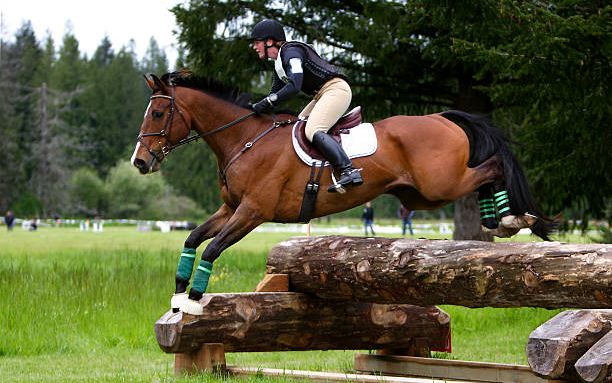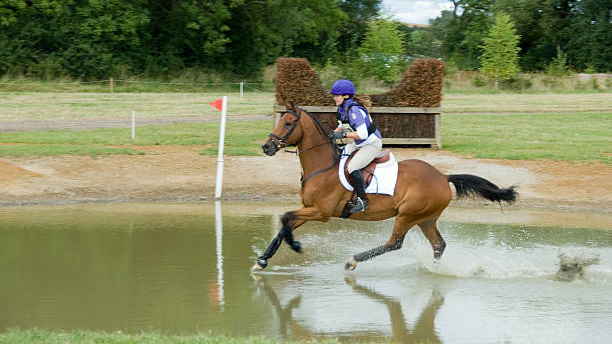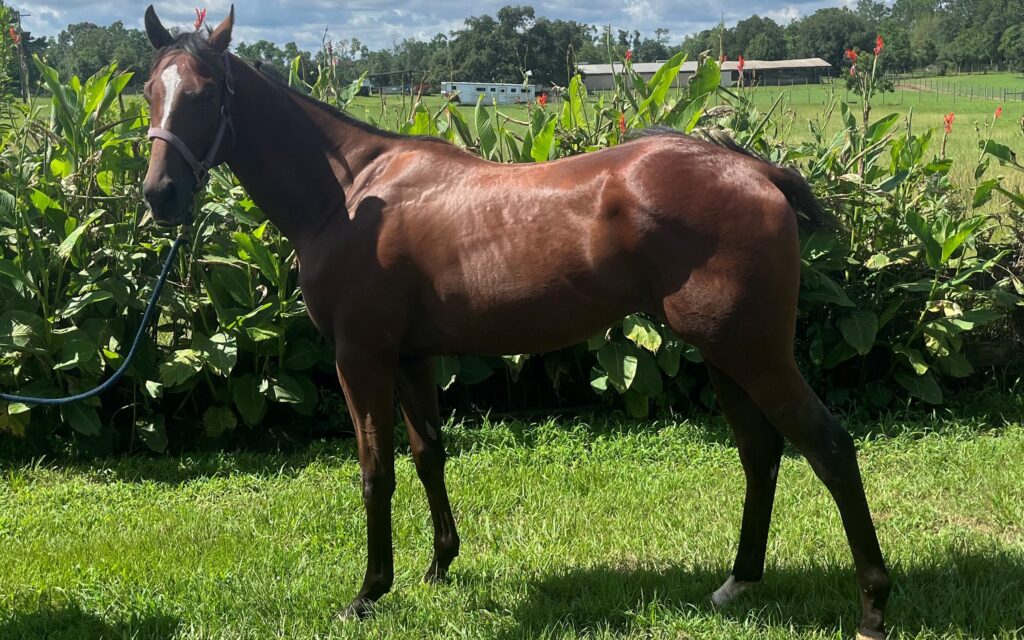Last updated: March 23, 2023
My granddaughter is fascinated by eventing competitions and wanted to know more about the cross-country portion, which is the third and final phase of these events. So we attended a few competitions and visited with some of the competitors to learn about this amazing sport.
Cross country is one of the most popular and exciting equine sports in the world. This equestrian discipline is a test of horse and rider, requiring a great deal of skill and stamina. The course typically consists of a series of fences, logs, ditches, and other obstacles that the rider must navigate in a timely manner.
Many riders consider cross country to be the ultimate test of their abilities, and it is an excellent way to showcase the skills of both horse and rider. If you’re interested in trying out this sport, keep reading to learn more.

What Are Cross Country Horse Competitions?
Cross country is a physically and mentally challenging sport that requires fitness and bravery. However, the trust bond between the rider and horse will allow the duo to successfully navigate a technically challenging course and is a confidence booster to those who complete a round of hair-raising obstacles.
In addition, this sport demands a particular type of horse and rider to compete. Cross-country, also known as hunter trials, is an endurance test of the horse’s speed, stamina, and jumping abilities, including obedience and conditioning. It also tests the rider’s knowledge of pace and the ability to ride the horse technically.
The course used for cross-country competition is designed outside in fields and wooded areas that incorporate the land’s unique terrain to create naturally intimidating-looking fixed obstacles that include logs, brush fences, ditches, slopes, and banks to test the horse’s bravery. Cross country horse competitions are popular because they showcase the unique bond between horse and rider,
Eventing
Cross country horse riding is one phase of a triathlon equestrian eventing sport of English riding that includes dressage and show jumping held over two to three days. It consists of different levels according to the rider and horse’s abilities, where they are judged on specific criteria that accrued penalties.
The cross country phase is scored on a penalty system, with riders accumulating penalties for refusals, falls, exceeding the optimum time, or taking too long to complete the course. The goal is to finish with the lowest number of penalties possible.
It also has an optimum time factor that tests the rider’s ability to control speed and the horse’s stamina and gets penalized if the pair does not complete the course in the required time frame. This is where bursts of galloping test horse and rider between fences.
The three phases of eventing – dressage, cross country, and show jumping – are combined to determine the overall winner, with the lowest total score determining the victor.
Hunter trials
Hunter trials are competitions that focus solely on the cross country phase, where horse and rider pairs navigate a course of natural obstacles similar to those found in eventing. The objective is to complete the course within the optimum time, with penalties given for refusals, falls, or time faults.
Hunter trials are an excellent way for riders to gain experience and confidence in cross country riding without participating in a full eventing competition.
Derby cross events
Derby cross competitions combine elements of both cross country and show jumping. Riders are required to navigate a course that includes both natural cross country obstacles and show jumping fences, testing their skills in a unique format. Derby cross events are often seen as a fun and less formal alternative to traditional eventing.
Schooling events
Cross country schooling shows offer riders the opportunity to practice navigating cross country courses in a more relaxed, non-competitive environment. These shows may have a variety of courses and obstacles available to suit different experience levels, allowing riders to build their skills and gain confidence in a supportive setting.
These standalone cross country competitions are popular among riders who want to focus on cross country skills or who may not have an interest in, or their horse may not be suited for, the other phases of eventing.

What Are The Levels Of Cross-Country?
There are national and international levels for cross country that determine in what class you are competing. In the United States, the national levels fall under the United States Equestrian Federation (USEF), while the British levels fall under the British Eventing (BE).
The international levels for Federation Equestre International (FEI) work on a five-star system with the CCI1* level equivalent to the USAE preliminary level and the BE novice level.
Each level has minimum eligibility requirement points (MER) that must be achieved for the rider and horse to be allowed to move onto the next level of cross country. There is also a ceiling for accumulated points per level to ensure fair competition and force experienced horses to move to the next difficulty level.
| Cross Country level (USAE) | Course Length | Course Pace | Number Of Jumps | Jump Height |
|---|---|---|---|---|
| Beginner novice | 1400-2000m | 300-350m/min | 14-18 efforts | 80cm |
| Novice | 1600-2200m | 350-400m/pin | 16-20 efforts | 90cm |
| Training | 2000-2600m | 420-470m/min | 20-24 efforts | 100cm |
| Modified Levels | 2200-3000m | 490m/min | 22-28 efforts | 105cm |
| Preliminary | 2200-3120m | 520m/min | 22-30 efforts | 110cm |
| Intermediate | 2600-3575m | 550m/min | 26-34 efforts | 115cm |
| Advance | 3200-3990m | 570m/min | 32-40 efforts | 120cm |
| Cross Country level (BE) | Course Length | Course Pace | Number Of Jumps | Jump Height |
|---|---|---|---|---|
| BE80 | 1600-2800m | 435m/min | 18-25 efforts | 80cm |
| BE90 | 1600-2800m | 450m/min | 18-25 efforts | 90cm |
| BE100 | 1800-2800m | 475m/min | 18-25 efforts | 100cm |
| BE100 Plus | 1800-2800m | 475m/min | 18-25 efforts | 100cm |
| BE105 | 2000-2800m | 500m/min | 20-27 efforts | 105cm |
| Novice | 2000-2800m | 520m/min | 20-28 efforts | 110cm |
| Intermediate Novice | 2000-2800m | 520m/min | 20-28 efforts | 110cm |
| Intermediate | 2600-3620m | 550m/min | 36-32 efforts | 115cm |
| Advance Intermediate | 2600-3620m | 550m/min | 26-32 efforts | 115cm |
| Advance | 3250-4000m | 570m/min | 30-40 efforts | 120cm |
| Cross Country level (FEI) | Course Length | Course Pace | Number Of Jumps | Jump Height |
|---|---|---|---|---|
| CCI1*-intro | 2000-3000m | 500m/min | 20-25 efforts | 105cm |
| CCI2*-S | 2600-3120m | 520m/min | 25-30 efforts | 110cm |
| CCI2*-L | 3640-4680m | 520m/min | 25-30 efforts | 110cm |
| CCI3*-S | 3025-3575m | 550m/min | 27-32 efforts | 115cm |
| CCI3*-L | 4400-5500m | 550m/min | 30-35 efforts | 115cm |
| CCI4*-S | 3420-3990m | 570m/min | 30-35 efforts | 120cm |
| CCI4*-L | 5700-6270m | 570m/min | 35-40 efforts | 120cm |
| CCI5*-S | 3705-4275m | 570m/min | 33-38 efforts | 130cm |
| CCI5*-L | 6270-6840m | 570m/min | 40-45 efforts | 130cm |

What Is Cross-Country Horse Riding Judged On?
In the cross country event of the triathlon eventing class, horses and riders need to ride the course with as few penalties as possible. If penalties are incurred for any faults, they are added to the dressage points the pair received the day before.
The aim is to complete the course with as few penalties as possible before moving on to the show jumping and the last part of the eventing competition. The equestrian pair is judged on a few criteria that may incur penalty points and faults that can lead to elimination.
- Horse disobediences
- Course errors
- Falls of rider or horse
- Time faults
Note: The team can be eliminated if they have three consecutive refusals at the same obstacle or four total refusals across the course.
Penalties can be marked as follows;
| Cross Country Judging | Faults | Penalty Points |
|---|---|---|
| Horse disobediences | First refusal, run-out, or circling at the fence2nd refusal for the same obstacle: 3rd refusal at the same obstacle4th cumulative refusal in total for the entire course | 20 penalties per obstacle40 additional penaltiesEliminationElimination |
| Course errors | Jumping obstacles in the wrong order Jumping a fence in a direction that is not flaggedOmission of a jump | EliminationElimination Elimination |
| Falls of rider or horse | If the rider falls, the horse falls, and its quarters and shoulders touch the ground. | EliminationMandatory retirement |
| Time faults | Every second that goes over the optimum time Exceeding the allowed time by twice that of the optimum time Speed Faults for every second under the Speed fault time (going faster than the course minimum time)Wilful delay to avoid speed faults | 0.4 penalties per second Elimination 0.4 penalties per sec 19 penalties |
| Others | Riding in a dangerous manner Wilfully obstructing an overtaking competitorFailure to stop on the course when signaledHorse’s head and front shoulder passing outside of the flags | 25 penaltiesElimination EliminationElimination |

What Are The Best Horses For Cross Country?
Most horses will be able to handle low-level cross country as long as they receive proper conditioning, are athletic, and demonstrate some bravery. When considering a riding horse for progressing through the levels to the top levels of cross country, it is essential to choose wisely and consider some requirements that make an excellent eventing horse.
Horses that excel at cross-country are intelligent, quick-thinking, able to think for themselves, and able to get out of difficult situations with bold and brave temperaments. Headstrong horses don’t make great cross-country mounts; your horse will need a high degree of obedience and trust. Agility is essential when looking for a cross-country horse and finding a horse with high stamina and speed.
Here are the top ten breeds used in cross country
| Breed | Characteristics |
|---|---|
| Irish Sport Horse | Persistent breed, high stamina. Good gallop pace, friendly demeanor, Energetic |
| Thoroughbred | High stamina levels due to large lungsAgile with a slim buildSpeedAthletic buildCourageous |
| Dutch Warmblood | Tall breedpowerfulIntelligentExtremely willing |
| Selle Francais | Fun and loving natureStrongAthletically builtCleaver and very keen to learn even-tempered |
| Hanoverian | Stamina Sturdy build, reliable and obedient Willingness makes them highly trainable Gentle with a trusting and calm demeanor. |
Conclusion
No other equestrian sport showcases the horse’s elegance, bravery, and power through three phases of competition, where cross-country forms one of the phases. It demonstrates the rider and horse’s abilities for technical difficulties, stamina, courage, and boldness while pushing the equestrian pair to the limit of their physical and mental boundaries.
Watch the YouTube video below to learn more about the Cross Country Horse Riding Competition.
FAQs
Is cross-country horse riding dangerous?
Yes, cross country is one of the most dangerous horse sports there is. There are many challenges that riders face when they’re out on the cross-country course, such as uneven terrain and obstacles like logs, ditches, and water crossings.
Is eventing the same as cross-country?
No. Cross country is one phase of eventing. In eventing, horses and riders are required to complete three different disciplines: dressage, show jumping, and cross-country.
Below are links to reference material that provides useful information about cross country competition.
- https://www.discovereventing.com/
- https://useventing.com/news-media/news/what-the-the-new-fei-star-system-explained
- https://www.topendsports.com/sport/list/equestrian-cross-country.htm
- https://horseandcountry.tv/en-us/cross-country-horse-riding-for-beginners/
- https://www.britisheventing.com/compete/rules-and-safety/penalties
- https://heelsdownmag.com/eventing-explained-what-to-expect-at-each-level/
- https://en.wikipedia.org/wiki/Eventing#Cross-country
- https://www.usef.org/forms-pubs/KlV5P9prkmM/ev-eventing-division
- https://fliphtml5.com/fwspv/jzen/basic

About the Author: Miles Henry
Lifelong Horseman | Racehorse Owner | Published Author
Miles Henry brings over 25 years of hands-on experience training and owning Thoroughbred racehorses. Raised with Quarter Horses and Appaloosas, he’s spent a lifetime learning from horses—on the track, in the barn, and in the field. Today, he runs a small but successful racing stable in Louisiana and shares real-world insights on HorseRacingSense.com, helping horse owners, fans, and bettors navigate the sport with confidence.
📚 Books: View Miles’s books on Amazon »
🎧 Podcast Guest: Animal Tales Ep. 32 |
YouTube Interview
📩 Newsletter: Sign up for racing tips and horse care advice »
🔗 Follow Miles:
Twitter |
Facebook |
YouTube


